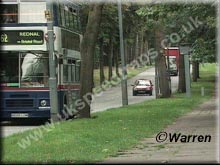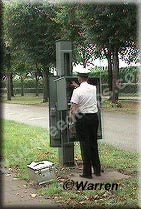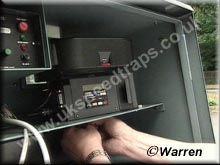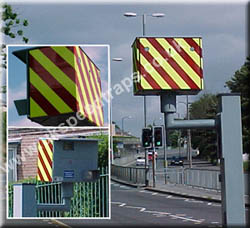Gatso Facts
  
A Gatso camera is a large ugly grey box that the police and council see fit to place anywhere they want along the roadside. Consisting of a radar unit, camera, and flash gun in most cases, although some Gatso cameras have inductive loops in the road rather than a radar. They read the speed of the passing vehicle by use of a speed measuring device (Inductive loop or Radar) and if the speed is above the set limit then it takes two pictures half a second apart of the offending vehicle.

Operators back at base can also manually calculate the distance traveled by the use of the white lines painted on the road allowing them to then work out your speed, should you disagree.
Known as the FIP (Fixed Installation Post )and currently manufactured by Gatsometer, in the Netherlands. The Radar operated units work on the K-band.
Recent changes in the Law mean that the Police Force issuing the NIP can now also claim costs for the paperwork, Hiking up the cost of your bill.
A GATSO STANDS OUT.... Are we seeing things.. 9th June 2000
Plymouth Council and the Police may be setting a precedent when it comes to Gatso cameras and the colour they are painted.
One Gatso camera has been covered in rather bold reflective red and yellow stripes and can be seen almost a mile away.
Now we all know they often like to hide Gatso cameras from the view of drivers because it helps their revenue, after all some of the best earners are the hidden ones. But we must ask ourselves if they are hidden are they really a deterrent, do they help us identify accident black spots or high-risk areas, no. Unlike some countries in the UK they are painted grey or black and in some cases more often than not they hide them as best as they can. In Holland they often paint them bright colours and show the speed on them as well.
Plymouth CC decided that one of their Gatso's was not doing its job to well, it was taking too many pictures of offenders 3000 in all. A Gatso that does its job well is one that never takes a picture. Plymouth CC decided to give one Gatso near a school a make over.

Above: Is this the new face of Gatso's
As yet its to early to see if it has worked, I an told the trial ends in December, if however it has made a difference what will happen next, will Plymouth CC then cover all the Gatso cameras the same way? They say, yes they will. Will they want the loss in revenue and if they do cover them all will other councils do the same?
Either way its a very good move in the right direction and Plymouth deserve a pat on the back for the brave move.
Its about time they stopped abusing the use of Gatso cameras just to add extra revenue into the Government purse.
Well done Plymouth Council and police for making the first move...
My thanks to Nat Parnell for taking the time to go out and get me the picture.
Follow up to this story.
The Association of Chief Police Officers, say they will advise every force in the country to go dayglo if figures show high-visibility cameras lead to lower speeds than anonymous grey boxes.
The Plymouth trial has been running for just 10 weeks on the A3064 near Wolseley - the average speed of motorists has already dropped from 34mph to 30mph - the speed limit on the stretch.
Traffic chiefs at Plymouth City Council, who came up with the idea, are so pleased with the results they plan to paint the authority's 26 other cameras after the six-month trial in December.
Their findings - which could also show a fall in the number of accidents - will appear in a consultation paper which will be sent to every council in Britain. Painting the camera cost just £250, according to IAM chief examiner Trevor Poxon. He said: "It's a cheap and effective way of reducing speeds and increasing safety. Taxpayers can't grumble about the cost."
An ACPO spokesman said: "We will encourage the scheme nationally if the trial does show a reduction in speed." The DETR also said it was interested.
Extract from MCM
NEWS on Digital Gatso, 10th June 1999
THE 400,000 drivers caught by automatic cameras last year will testify that "Gatso's" aren't turkeys.
But the police have so far failed to use their speed cameras in the way they really want.
The Gatso speed trap was invented by Dutch rally driver Maurice Gatsonides, who died last December. Doppler radar senses vehicle speed and triggers a flash gun and camera. The flash fires twice to photograph the vehicle as it passes marks on the road. The number of marks passed in the fixed time between the two flashes shows the car's speed.
The radar and flash units are cheap. The camera is very expensive and replacing the film in roadside cameras is dangerous and labour-intensive. So only one in six Gatso's works.
Two years ago, police photographers came up with the idea of replacing film with digital video cameras that connect by optic fibre cable to the Vehicle Registration Computer in Swansea.
So, as roadside cameras flashed round the country, the images would be sent to Wales for hard-disc storage. Optical character recognition circuitry would tie the car number to the registered owner and print out a penalty notice for automatic posting.
Digital video cameras are now cheap and, with no need for the police to replace film, every flash could generate big return on low investment. Police lawyers canned the project, by warning that a defence lawyer would only need to ask only one simple question in court. "Is it possible that the digital image could have been altered while stored in the computer?" The police are still looking for a digital watermark system that would permit the honest answer: "No."
More speed cameras on way as prosecutions rise
THE number of drivers prosecuted after being caught on cameras speeding or running red lights has risen by 25% to nearly 400,000 in the last year - and more roadside cameras are expected to be installed.
This year, the number is set to be even higher as the police, councils and courts will be allowed to keep the money from camera fines. The Government has announced it intends to make £15.6million of fine income available to fund new camera schemes each year.
This has been agreed following lobbying from the Association of Chief Police Officers which said that, without extra cash, it was not possible to buy and service cameras: they cost £20,000 to buy and the same amount to maintain a year. Thousands of cameras now overlook all types of roads in the UK but it has been suggested that a lack of resources means only 130 at any one time are active. Home Office figures show that 390,008 offences were captured on camera in 1997 - 86% of for speeding.
What no film !
POLICE are removing film from roadside speed cameras, or raising the limit at which they take pictures, to cut the cost of prosecuting motorists.
The Association of Chief Police Officers conceded that the practice was "not a good road safety message". The admission that police are cutting down on camera use came from Geoffrey Markham, assistant chief constable of Essex and association spokesman on speed enforcement.
It follows findings in the 1997 Lex report on motoring that two-and-a-half million drivers recalled being flashed by cameras as they speed but only one in eight - around 300,000 - were prosecuted.
Many forces are having difficulties in meeting the extra administrative costs involved".
No extra funding had been made available to police and, although accident prevention might be a priority for some forces, it did not feature in the Government's national policing objectives.
Forces "are dealing with this particular resource problem in a variety of ways, which can include not placing film in cameras and adjusting prosecution thresholds" - a reference to raising the speed at which cameras take a picture.
For example, a camera might be reset at 50mph rather than 45mph in some areas. Leaving cameras empty would still be a deterrent because motorists slowed on seeing cameras. The association was unable to say how much the system was costing police or which forces were particularly affected by the costs.
The AA also supports the setting of speed trigger limits at a "realistic level," balanced against resources available and chances of prosecuting offenders.
The Home Office said the Government was considering the general funding of the speed camera system.
In some 30mph zones in Kent the fixed penalty only comes in above 45mph and only if someone drives over 57mph will they be taken to court
|




